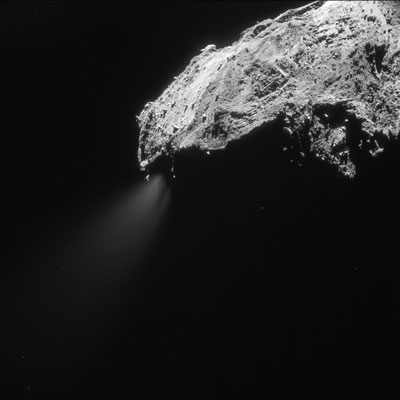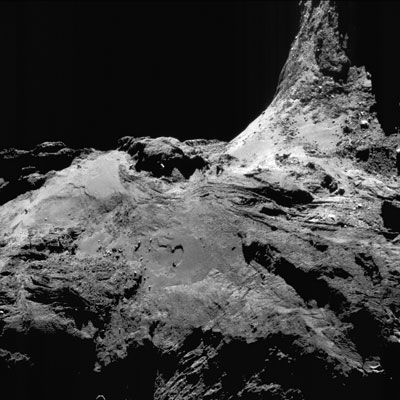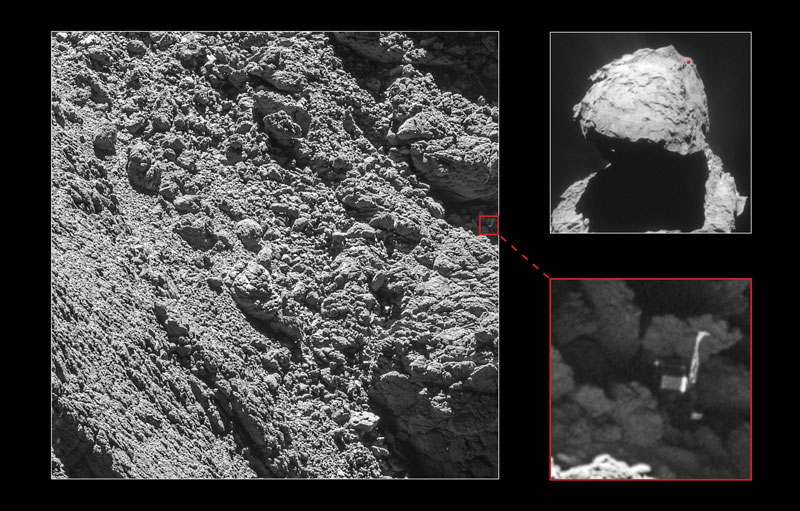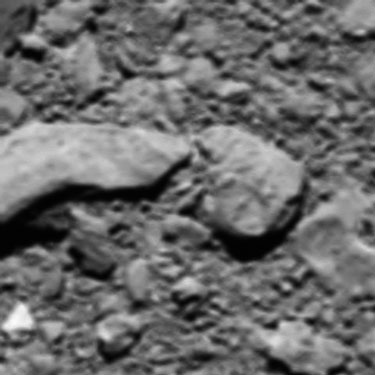One year ago tomorrow, a spacecraft called Rosetta crashed into a comet.
The crash was purposeful—the dramatic end to humanity’s first mission to orbit one of these many dirty ice balls floating around our solar system.

The Rosetta mission, with its washing machine–sized lander Philae, brought us tantalizing images of an alien world, the rubber duck–shaped comet 67P/Churyumov-Gerasimenko. Rosetta launched in March 2004 and spent a decade on its way to comet 67P, whipping three times around Earth and once around Mars for gravity assists, before arriving at the comet on 6 August 2014.
For the next 2 years, Rosetta took nearly 70,000 images, studied the comet’s surface, and even followed 67P through its closest approach to the Sun in its 2,398-day orbit (that’s about 6.5 years).
Matt Taylor, Rosetta’s project scientist at the European Space Agency, which partnered with NASA on the mission, remembers the hectic 2 years of the mission’s main phase when Rosetta orbited the comet. He woke up every morning thinking about the spacecraft and went to sleep every night thinking about the spacecraft. He and the international team of scientists spent every second collecting as much data as possible while simultaneously making sure the spacecraft was orbiting the comet correctly.
“I think it took a year for a lot of us to recover from the mission,” Taylor said. When he talks to colleagues now, he finds that many of them “miss that camaraderie of that intensity” of near-constant operations, making sure the spacecraft was healthy while also stockpiling data.

In those 2 years, scientists discovered many things about the comet that have implications for its formation and that of our solar system’s rocky planets. Rosetta found molecular oxygen, for instance, which needs very low temperatures to stay trapped in the comet’s ices. This finding means the comet probably formed far from the Sun, in a very cold region of the preplanet nebula. Rosetta also found simple organic molecules, including the amino acid glycine.
“One can then look at comets as being a kind of capsule containing the ingredients of the solar system frozen in time,” Taylor said.
The Rosetta mission has started answering basic questions about planetary formation, said Bonnie Buratti, Rosetta’s project scientist on the NASA side. As Rosetta flew toward its intentional crash into the comet in late September 2016, it snapped pictures of the body’s surface. In those fine-scale pictures scientists saw tinier and tinier pebbles making up the boulders, a sign of accretion of tiny bits into a larger body. In a sense, comet 67P is “a planet in formation,” Buratti said.

Time to Breathe
“The spacecraft lives on through its data.”
Even though the mission ended a year ago, “the spacecraft lives on through its data,” Buratti said.

In the coming years, Buratti looks forward to scientists new and old answering more questions about the comet, like Where did the comet’s oxygen come from? How did the comet get that funny shape? How much of Earth’s water comes from comets?
Buratti is excited to learn more about the internal workings of the comet, particularly the noble gases Rosetta found, like argon, krypton, and xenon. These gases are important to study because scientists think that some of the noble gases in planetary atmospheres came from comets.
Already, scientists have found that 22% of the xenon in Earth’s atmosphere has cometary origins—with every breath you take, you might be inhaling comet.
“When you’re a scientist, you do look upon the spacecraft as an extension of your own senses,” Buratti said. “There are great discoveries that are going to be made. That’s what I’m beginning to realize.”
—JoAnna Wendel (@JoAnnaScience), Staff Writer
Citation:
Wendel, J. (2017), More discoveries in the cards from defunct comet mission, Eos, , https://doi.org/10.1029/2017EO083385. Published on 29 September 2017.
Text © 2017. The authors. CC BY-NC-ND 3.0
Except where otherwise noted, images are subject to copyright. Any reuse without express permission from the copyright owner is prohibited.

